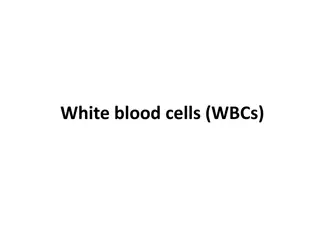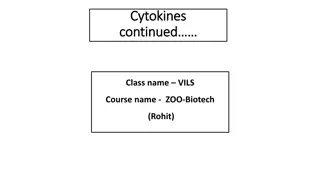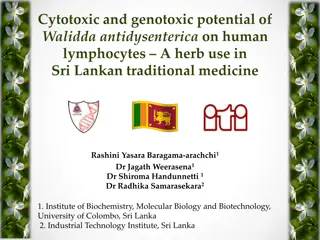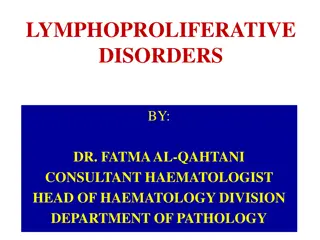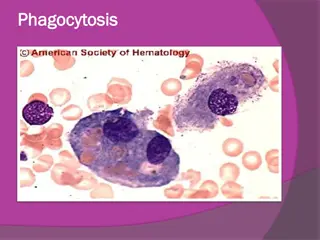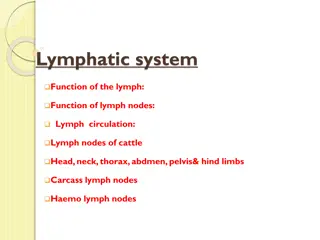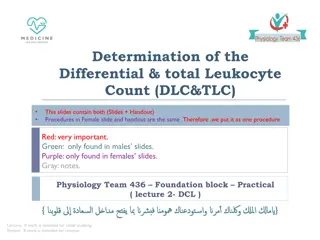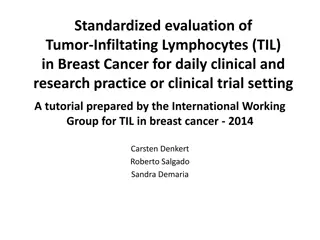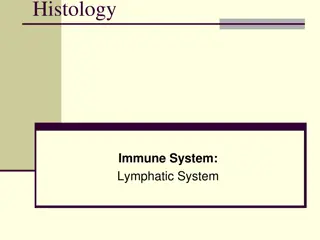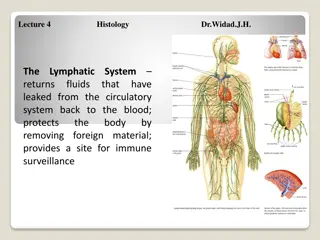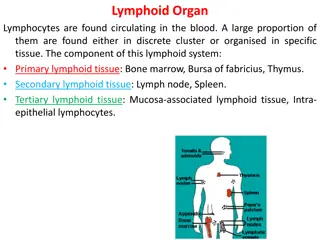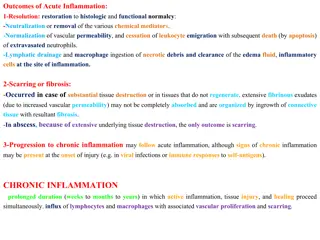Differential white blood cell count
Differential white blood cell count, also known as a leukocyte count, is a crucial test to determine the different types of white blood cells present in the blood. The cells are classified into granulocytes (neutrophils, eosinophils, basophils) and agranulocytes (lymphocytes, monocytes). Blood smear
3 views • 21 slides
Understanding Lymph Node Examination in Food Animals
The lymphatic system plays a crucial role in maintaining the body's health by supplying oxygen and nutrients to tissues and removing waste products. Lymph nodes are round masses of lymphoid tissue found along lymphatic vessels, containing lymphocytes within a capsule of connective tissue. Characteri
1 views • 9 slides
Understanding White Blood Cells and Their Classification
White blood cells (WBCs), or leukocytes, are vital elements of the blood responsible for protecting the body against invading organisms. They are classified into granulocytes (neutrophils, eosinophils, basophils) and agranulocytes (monocytes, lymphocytes), each playing specific roles in the immune s
1 views • 28 slides
Understanding the Significance of Cytokines in Immune Response
Cytokines play a crucial role in immune response activation and regulation. They are secreted by various cell types like lymphocytes, monocytes, and macrophages, exerting diverse biological functions, including immune system development, inflammatory response induction, and hematopoiesis regulation.
2 views • 12 slides
Understanding Host Defense Mechanisms Against Infection
Host defense mechanisms safeguard the body from pathogens through various strategies such as intact skin, mucous membranes, nonspecific immune responses like phagocytic cells, and specific immune responses involving antibodies and lymphocytes. Key protective barriers include the skin, eyes, digestiv
3 views • 16 slides
Understanding Leukopoiesis: The Development of White Blood Cells
Leukopoiesis is the process of white blood cell production, crucial for defending the body against foreign agents. Granulocytes and lymphocytes are key components, with granulocytes found in different locations like the bone marrow, blood, and tissues. The bone marrow pool plays a vital role in the
2 views • 23 slides
Cytotoxic and Genotoxic Potential of Walidda Antidysenterica on Human Lymphocytes: A Study in Sri Lankan Traditional Medicine
Investigating the cytotoxic and genotoxic effects of Walidda antidysenterica extracts on human lymphocytes in Sri Lankan traditional medicine. The plant is widely used for its diverse medicinal properties, including treating various diseases and promoting overall health. The study aims to understand
0 views • 27 slides
Understanding Cutaneous Manifestations of HIV and AIDS
Human Immunodeficiency Virus (HIV) is a lentivirus that infects CD4 T lymphocytes, leading to Acquired Immunodeficiency Syndrome (AIDS). Cutaneous manifestations of HIV/AIDS vary depending on the stage of infection and CD4 T cell counts. Early signs include exanthem, oral hairy leukoplakia, candidia
0 views • 17 slides
Understanding Lymphoproliferative Disorders: A Comprehensive Overview
Lymphoproliferative disorders encompass various clinical conditions involving the excessive production of lymphocytes, such as lymphoma and lymphoid leukemia. This article delves into the definitions, causes, and specific types of lymphoproliferative disorders, including infectious mononucleosis and
0 views • 27 slides
Understanding Phagocytosis, Inflammation, and Granulomas in Tuberculosis
Phagocytosis is a crucial process where cells engulf and digest pathogens. Inflammation responses involve various immune cells like neutrophils, plasma cells, lymphocytes, and macrophages. Granulomas, typical in diseases like tuberculosis, are mass accumulations in chronic inflammation. Tuberculosis
0 views • 18 slides
Understanding Immunology: Key Players and Processes
Explore the world of immunology through key components such as monocytes, macrophages, lymphocytes, interferons, and the inflammatory reaction. Learn about the roles of various immune cells in defending the body against pathogens and the mechanisms of inflammation in response to tissue damage or inf
0 views • 16 slides
Understanding the Lymphatic System in Cattle: Nodes, Circulation, and Function
The lymphatic system in cattle plays a crucial role in maintaining overall health. It consists of lymph nodes located in various regions of the body such as the head, neck, abdomen, and hind limbs. These lymph nodes produce lymphocytes and help in filtering foreign bodies. Lymph fluid, similar to bl
0 views • 39 slides
Understanding Differential and Total Leukocyte Count (DLC & TLC)
Differential and Total Leukocyte Count (DLC & TLC) is a crucial test that determines the percentage of different types of white blood cells in the total leukocyte population, aiding in diagnosing various disease processes. The test involves identifying and counting different types of white blood cel
0 views • 18 slides
Tutorial on Standardized Evaluation of Tumor-Infiltrating Lymphocytes in Breast Cancer
This tutorial, prepared by the International Working Group for TIL in breast cancer, provides guidelines for pathologists on the standardized evaluation of tumor-infiltrating lymphocytes (TILs) in breast cancer based on H&E slides of core biopsies or tumor resections. It details steps such as defini
0 views • 14 slides
Understanding the Lymphatic System and Immune Response
The lymphatic system, a vital component of the immune system, consists of lymphocytes, plasma cells, and other cells within a framework of reticular cells and fibers. It includes lymphoid organs like the bone marrow, thymus, lymph nodes, and spleen. Diffuse lymphatic tissue and lymphatic nodules are
0 views • 20 slides
Overview of the Lymphatic System and Immune Response
The lymphatic system plays a crucial role in returning leaked fluids back to the blood, protecting the body from foreign materials, and supporting immune surveillance. It consists of lymphoid cells such as T and B lymphocytes, macrophages, dendritic cells, and reticular cells that work together to d
0 views • 31 slides
Understanding the Lymphatic System: Functions and Importance
Lymph is a clear, colorless fluid that plays a crucial role in maintaining the body's fluid balance, immune response, and lipid absorption. The lymphatic system functions to return excess fluid and proteins to the bloodstream, aid in immunity through lymphocytes, absorb dietary lipids, and regulate
0 views • 13 slides
Understanding Hodgkin Disease and the Lymphatic System
Hodgkin disease is a type of lymphoma affecting white blood cells, with key characteristics like Reed-Sternberg cells. It starts in lymph nodes and can spread through the lymphatic system. Lymphocytes, B and T cells, play vital roles in the immune response. The lymphatic system, comprising lymphoid
0 views • 19 slides
Overview of Lymphoid Organs and Their Functions
Lymphocytes are crucial components of the lymphoid system, found in various lymphoid organs like the bone marrow, thymus, lymph nodes, and spleen. The primary, secondary, and tertiary lymphoid tissues play distinct roles in lymphocyte development, differentiation, and immune responses. Dysfunction o
0 views • 21 slides
Understanding Acute and Chronic Inflammation: Causes, Outcomes, and Resolution
Acute inflammation results in either resolution or progression to chronic inflammation, with outcomes like restoration of normalcy, fibrosis, or scarring. Chronic inflammation can be caused by viral infections, persistent microbial infections, exposure to toxic agents, or autoimmune diseases. Macrop
0 views • 27 slides


